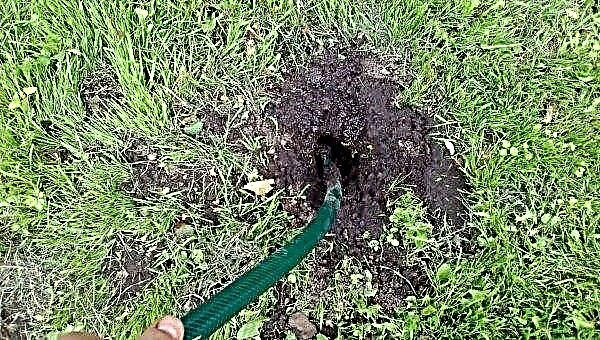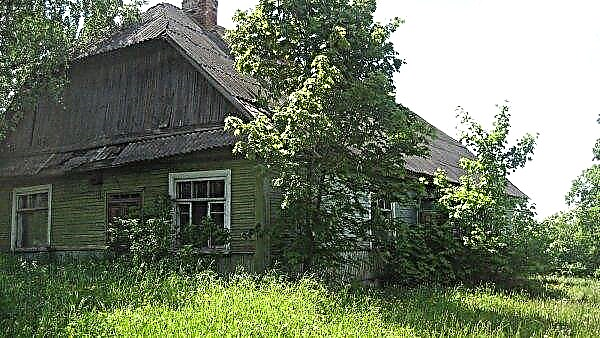To create a gazebo, you can use different types of foundations. A solid foundation is the key to longevity of construction. The laying of the supporting structure is possible even when the construction is carried out on soft or crumbly soil. Read more about how to make a foundation for a gazebo in the country with your own hands, read the article.
Foundation options for the gazebo
It is very important to create a foundation without errors in order to guarantee an even floor. In addition, if the flooring is not even from the very beginning, this will create a problem when installing walls and roofs, which is especially important for such small structures as arbors.
You can choose one of several types of foundation. Some of them are simple, others are more complex. For a small gazebo, columnar or tape are suitable, and for a large structure, use the slab type of base. In an area with a close occurrence of groundwater, pay attention to the pile foundation.Did you know? An example of the most unsuccessful foundation in history is the Leaning Tower of Pisa. It is built on soft soil using a shallow base that cannot support the weight placed on it.
Tiled
The slab foundation is a concrete base in the form of a slab. Walls will subsequently be installed on it. The design is in demand where, for technical reasons, it is impossible to lay a wooden floor. For example, in garages and pools. Such buildings need a solid and reliable foundation, which requires minimal maintenance. It is also used where a half-mosaic is mounted or covered with decorative plates.
 For the construction take cement brand M500. The solution is easy to prepare and has excellent performance characteristics, including frost resistance. It begins to set in 45 minutes after kneading and completely hardens within 28 days.
For the construction take cement brand M500. The solution is easy to prepare and has excellent performance characteristics, including frost resistance. It begins to set in 45 minutes after kneading and completely hardens within 28 days.
The foundation is not buried too deep in the ground and is used in areas with a bearing capacity of 2.5 kg / cm². This group includes sandy soils, clay and loam, peatlands and soils with high humidity. It is also convenient on stony uneven areas where it serves as a base for leveling the floor. To make the construction durable, use clean coarse sand and medium gravel (20–40 mm) without impurities and debris. The preparation of the solution will consist of thoroughly mixing all the dry components. Then add water in portions, bringing to the desired consistency.
For construction you will need:
- hammer;
- tamper;
- concrete mixer;
- building level;
- bucket;
- shovel;
- building cord and pegs;
- formwork boards;
- steel reinforcement;
- crushed stone of the middle fraction;
- sand;
- cement M500.

A typical slab foundation for a gazebo should have a base in the form of:
- gravel pillows about 10 cm thick;
- concrete site with a height of at least 10 cm.
It is also important to remember that the gazebo will be more simplified than the foundation for the construction of the cottage.Important! Under the influence of temperatures, concrete has the property of expanding and narrowing. Therefore, it is undesirable to create a site with a tight fit to another concrete structure.

Creating a foundation step by step:
- Clean the area from weeds. The roots of grasses, especially bushes, are removed from the construction site in order to exclude their decay and decomposition under the basement of the arbor.
- Set the layout of the future slab foundation with construction pegs and a cord.
- Remove the top 20 cm of soil with a shovel. This is fertile soil that can be used for bedding.
- Then deepen the pit to the desired size. According to GOST 10180-2012, the minimum thickness of such a platform should be 100 mm. For reliability, it can be reinforced with steel wire.
- Install wooden formwork around the construction site. Boards for it are fastened along the edges with self-tapping screws. Be sure to check the leveling of the surface level.
- Compact the soil with a tamper and place a layer of sand on it, and then a crushed stone layer 10 cm thick. Each of them is also compacted, and for better compression, moisten the material.
- Lay a layer of geotextile over the pillow. Its task is to prevent contact of the base and moisture coming from the ground. In addition, it will prevent crushed stone from spreading to the sides under the mass of the solution.
- On the formwork, beacons with notches can be installed to control the fill level. Between them, pull the building cord in increments of 0.5 m.
- If the structure needs to be strengthened, drive reinforcement into the ground and tie it together with a steel wire.
- Prepare a mixture for pouring from cement, crushed stone and sand in a ratio of 1: 2: 3. Pour water so that the mass is plastic, but it should be no more than half the total weight of dry materials. If crushed stone is not added to the mixture, then the ratio of components will be 1: 1.
- After the site is flooded, it is left to dry, after being punctured in several places with a steel rod for air to escape from the liquid mass.
- Remove the formwork after the concrete has hardened.
- Full solidification occurs within a month.

Tape
The strip foundation is a contour created by:
- from reinforced concrete beams;
- concrete poured into the trench.
Did you know? All the foundations of antiquity tape and it is on them that archaeologists find out what the building looked like. The most famous mention of the tape type of foundation can be considered the Tower of Babel.
The price difference of both designs is negligible. The important thing is that the fill allows you to create a rounded or oval shape. And even a square or a rectangle can be different, while cutting reinforced concrete beams to the required size is quite problematic. A feature of the tape base is that the load from the wall to the ground goes at an angle of 45 ° and the depth of the base must be equal to or greater than the width. The minimum thickness of the "tape" is 150 mm.

This type of foundation is installed where there are no seismic vibrations of the soil that can cause destruction.
It has the following characteristics:
- thickness equal to or greater than the projection of the wall and never less than 150 mm;
- remoteness to trees at a distance of at least 2 m, which will allow to exclude ground vibrations due to root growth.
The strip foundation is convenient in that when it is created, fewer building materials are used than when creating a concrete site. It is also installed on a sand and gravel pad using waterproofing.
 To create the foundation by pouring, you will need the same tools and materials as during the construction of the site. Or you should buy reinforced concrete beams, the joints between which will need to be covered with concrete.
To create the foundation by pouring, you will need the same tools and materials as during the construction of the site. Or you should buy reinforced concrete beams, the joints between which will need to be covered with concrete.
Creating a strip foundation with your own hands:
- Clean the area of rubble, grass, shrubs and roots that fall under the structure. If it is flat, and the soil is clayey and capable of holding water for a long time, then a slight slope must be provided to ensure a natural flow of water.
- Make sure that there is at least 1.5 m between the building and the nearest buildings.
- Mark the outer contour with a building cord and pegs. Start marking from the corner, then draw the first line, set aside the next corner, etc. At the end, check the accuracy of the outline. Between the diagonals, an error of not more than 2 cm is allowed.
- Start digging a trench. Remove and use the upper fertile soil layer in the garden or on garden beds. The rest of the seized soil can be removed from the site.
- When the trench is ready, check the correctness of its size using the building level. Correct if necessary by adding or removing soil. Do not forget about the installation of formwork. For its installation, the pit should be larger than the size of the foundation is required.
- Mount the formwork to prevent the walls from shedding. It will take 2 rows of boards installed on both sides.
- Lay a pillow of crushed stone at the bottom. Seal it with a tamper. To level the surface, it is recommended that sand be poured on top, but since it is a question of pouring, this is not necessary.
- Lay waterproofing over a layer of rubble and sand. It should prevent the rise of moisture from the ground to the floor of the gazebo.
- To reinforce the structure, install fittings. Mount a protective reinforcing mesh along the walls. Cross reinforcement in increments of 40–80 cm.
- Then proceed to create concrete. If it is prepared from cement, gravel and sand, then the ratio of components will be 1: 2: 3. You can also use the recommendations of the cement manufacturer. Typically, bags contain a description of cooking technology.
- Pour the prepared solution into the trench.
- After that, it remains to wait until it completely hardens, then remove the formwork and proceed to the next stage of construction of the gazebo.

Pile
Pile foundation is used when the bearing capacity of the soil is insufficient to withstand loads that are transferred to deeper layers. The structure is formed from long, thin, columnar elements and made of reinforced concrete or wood. The depth of such a base is 3 times its width. The pile foundation is used for large and heavy structures, under the weight of which the soil will sag. In the upper part of the piles, a tape strapping is collected and the structure itself is installed on it.
Important! To fill the concrete evenly, on the inner side of the formwork boards mark elevation marks with a marker. When applying, check the correctness using the building level.
Piles can be classified by their main structural function. Racks will rest against the ground. They develop most of their friction in that part on which they rely. Screw piles have spiral blades near the bottom. This is necessary to "screw" them into the ground. This design is used on flooded areas or in ponds when creating a house on the water. Screw constructions are also convenient in that after "screwing" into the soil they are immediately ready for further use. For the installation of piles, regardless of their shape and design features, special equipment is used.
 The simplest pile foundation is the installation of pipes into which concrete is poured and reinforcement is placed. And then they “put” on them a strip foundation. This is convenient when creating outbuildings in the yard. For example, a chicken coop.
The simplest pile foundation is the installation of pipes into which concrete is poured and reinforcement is placed. And then they “put” on them a strip foundation. This is convenient when creating outbuildings in the yard. For example, a chicken coop.
- Among the advantages of this design:
- a small amount of building materials;
- universality;
- high installation speed;
- low cost.
Before starting work, you need to determine the number of piles to hold the weight of the structure and the optimal size of the construction site. This is important when installing a house on the water, but not so important if you are building a small gazebo in the garden.
Did you know? The pile-pile foundation allows you to create skyscrapers. Tallest building in the world The Burj Khalifa in Dubai (height 828 m) is built on this type of foundation.
Construction of the pile foundation:
- If you have unstable soil, start with an engineering project. Based on soil conditions, specialists will develop it with the calculation of the number of elements and their placement.
- To install the piles, excavate the soil, then start mounting the pole or installing a pipe into which concrete should be poured. Insert the fittings into it.
- Place the place between the pipe and the ground with crushed stone and compact.
- Connect the surface of the piles in a single structure using reinforced concrete beams. They will support a reinforced concrete slab or suspended floor of one kind or another.
 An alternative to drilling and excavating is driving a pile with a hydraulic ram or hammer. At the same time, the soil is displaced into the soil layers.
An alternative to drilling and excavating is driving a pile with a hydraulic ram or hammer. At the same time, the soil is displaced into the soil layers.
Columnar
The column foundation is mounted on supporting poles. They are immersed in soil to a certain size and partially rise above it. The material for construction is concrete blocks, brick, cinder block or asbestos-cement pipes and concrete. One post should be at the corners of the structure and one at a time in the center of the supporting walls. If the building is large, then they are placed in increments of 0.5-0.7 m.
It is worthwhile to erect support pillars from bricks if they do not need to be installed too deep - up to 1 meter. The minimum column width is 38 cm. Concrete structures are created more often, and they are considered very reliable. The reinforced concrete pillar is designed for a load of more than 11 tons, so it will perfectly support the weight of a gazebo or other courtyard building.
Cinder block is the same masonry material as brick. It can be used to create shallow pillars with a depth of up to 1 meter. It is only necessary to take into account that according to GOST, the length of such a building element is 380-410 mm, it will also determine the size of the column. And since the cinder block is hollow inside, it is impractical to cut it into parts to reduce the size.

Do not use columnar foundations:
- in places with seismic activity;
- on unstable soils;
- for massive stone cottages.
Creating a column foundation:
- Clean the area on which the gazebo will be installed from grass, shrubs and stones.
- Drive in the pegs and pull the building cord, marking the contours of the foundation. Check the geometric correctness of the design. Deviation of the diagonals is allowed no more than 2 cm. If they are equal, then the path is created correctly.
- With a paint or peg, mark the places where the center of each column will be located.
- Before digging, check the correct size calculation.
- Dig holes 30 cm wider than the size of the pillars.
- The bottom of the recess should be flat. If it is inconvenient to remove the soil with a shovel, use a spatula to level it.
- Then pour crushed stone up to 30 cm thick to the bottom.
 Further development of the construction process depends on how the pillars will be formed. If it is a long reinforced concrete pile, then a layer of concrete about 20 cm thick is poured onto the bottom. Then the pile is lowered into the recess and covered with gravel on its sides.
Further development of the construction process depends on how the pillars will be formed. If it is a long reinforced concrete pile, then a layer of concrete about 20 cm thick is poured onto the bottom. Then the pile is lowered into the recess and covered with gravel on its sides.
In the case when a pipe is installed inside, concrete is poured into it and reinforcement made of steel wire is loaded. Crushed stone is poured around and compacted. To create a column of concrete, a mixture of sand, cement and gravel is prepared to provide reinforcement and prevent cracking. The first part of concrete is poured into the prepared recess. This is the actual basis of the design. Then, a reinforcing mesh is immersed in it, rolled up in the form of a roll and concrete is added. Steel reinforcement is introduced into the surface of the column.
Important! When creating a column foundation, it is important to align the height of the columns. They should be located on one horizontal level.
For the gazebo, a pit depth of up to 1 m will be enough. The reinforcing crate should rise 20 cm above the surface. After 2–4 weeks, the concrete will harden and you can proceed with the installation of the harness and the further installation of the gazebo floor.

How to pour concrete under the gazebo
When creating concrete sites, there are a number of nuances that must be taken into account. So, tree roots or weather conditions can damage it.
To prevent this from happening, consider the following:
- The roots of the trees extend along the diameter of their crown. So the foundation should be farther than the roots of the nearest tree. Old trees do not increase in size, so installing a site next to them is better than near young trees.
- The resistance of the foundation to cracking depends on the quality of the material used.Therefore, sand and gravel should be clean, and cement - fresh. If it is stored for a long time, then its quality is reduced.
- To prevent contact of soil moisture and the floor of the gazebo, it is necessary to use a waterproofing membrane between the crushed stone layer and concrete.
- To ensure that the site is level, you need to accurately place the formwork, and then apply height marks on it to help level the surface during pouring.
- Concrete is poured at several points so that it can be leveled across the site, and not stretched, otherwise height differences will inevitably result.
- Further work is carried out after the mass has dried.

The application of a particular foundation design depends on the type of soil, mass and form of construction. The right choice provides the gazebo with durability, and it will serve you for many years.












